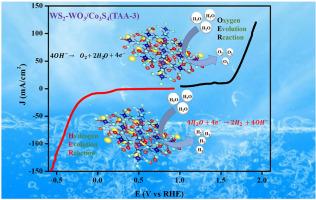对 ZIF 衍生的 Co3S4 在 1T-WS2/WO3 上用于电化学水分离的电催化机制的协同见解
IF 8.1
2区 工程技术
Q1 CHEMISTRY, PHYSICAL
引用次数: 0
摘要
设计一种用于氢进化反应(HER)和氧进化反应(OER)的高效双功能电催化剂,是通过电化学水分离产生大量氢燃料的明智方法。在此,我们在 WS2-WO3 上开发了一种用于整体水分离反应的高性能 ZIF 衍生 Co3S4 电催化剂。在开发 WS2-WO3 混合相时,硫代乙酰胺(TAA)作为硫源发挥了关键作用,并作为插层剂通过可能产生的 NH4+ 离子扩大了 1T WS2 的层。纳米级 Co3S4 在 WS2-WO3 上的均匀掺杂和可调特性实现了高电催化性能。该电催化剂具有显著的 HER 性能,过电位仅为 73 mV;在 10 mA/cm2 的条件下,OER 效能良好,过电位为 307 mV。长期的定时电位计和 CV 循环性能证明了电催化剂的稳定性。在不对称装置中,WS2-WO3/Co3S4 电催化剂实现了合理的双电极整体水分离性能,为设计和优化用于可再生能源转换的电催化剂铺平了道路。本文章由计算机程序翻译,如有差异,请以英文原文为准。

Synergistic insights into the electrocatalytic mechanisms of ZIF-derived Co3S4 on 1T-WS2/WO3 for electrochemical water splitting
Designing a highly effective bifunctional electrocatalysts for hydrogen evolution reaction (HER) and oxygen evolution reaction (OER) is a sensible approach for generating enormous hydrogen fuel by electrochemical water splitting. Herein, a high performance of ZIF-derived Co3S4 on WS2-WO3 electrocatalyst was developed for overall water splitting reactions. For developing the mixed phase of WS2-WO3, thioacetamide (TAA) played a crucial role as a sulfur source and acted as intercalating agent for expanding the layers of 1T WS2 via the possible generation of NH4+ ion. The high electrocatalytic performances is attained by the homogeneous incorporation and tunable properties of nano-sized Co3S4 on WS2-WO3. The electrocatalyst showed remarkable HER performance with an overpotential of only 73 mV and good OER efficiency with an overpotential of 307 mV at 10 mA/cm2. The long term chronopotentiometry and CV cycles performances convinces the stability of the electrocatalysts. A reasonable two-electrode overall water splitting performance was achieved by the WS2-WO3/Co3S4 electrocatalyst in an asymmetric device, paving the path for more developments in the design and optimization of electrocatalysts for renewable energy conversion.
求助全文
通过发布文献求助,成功后即可免费获取论文全文。
去求助
来源期刊

International Journal of Hydrogen Energy
工程技术-环境科学
CiteScore
13.50
自引率
25.00%
发文量
3502
审稿时长
60 days
期刊介绍:
The objective of the International Journal of Hydrogen Energy is to facilitate the exchange of new ideas, technological advancements, and research findings in the field of Hydrogen Energy among scientists and engineers worldwide. This journal showcases original research, both analytical and experimental, covering various aspects of Hydrogen Energy. These include production, storage, transmission, utilization, enabling technologies, environmental impact, economic considerations, and global perspectives on hydrogen and its carriers such as NH3, CH4, alcohols, etc.
The utilization aspect encompasses various methods such as thermochemical (combustion), photochemical, electrochemical (fuel cells), and nuclear conversion of hydrogen, hydrogen isotopes, and hydrogen carriers into thermal, mechanical, and electrical energies. The applications of these energies can be found in transportation (including aerospace), industrial, commercial, and residential sectors.
 求助内容:
求助内容: 应助结果提醒方式:
应助结果提醒方式:


